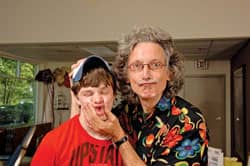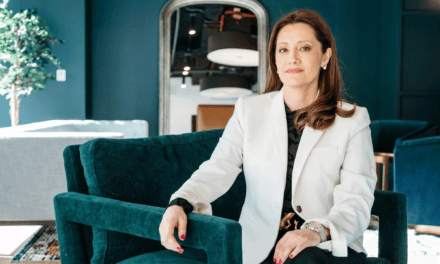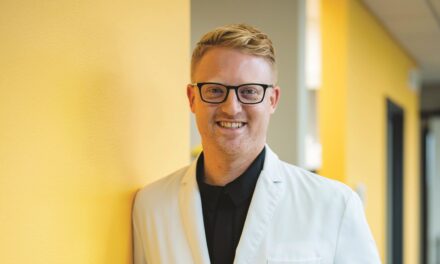by Rich Smith
Gerald S. Samson, DDS, ABO, FACD, makes biomechanics fun
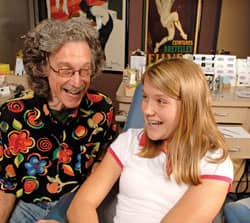
Gerald (Gerry) S. Samson, DDS, ABO, FACD, starts between 60 and 70 cases per year and sees no more than 30 patients per week at his practice in Marietta, Ga. For most orthodontists, numbers like those would spell financial danger. Samson, however, is no ordinary orthodontist.
For one, Samson generally charges higher fees than his colleagues in and around Atlanta, where he is located. What allows him to command premium rates is his commitment to provide care at a more comprehensive and sophisticated level than busier offices can reasonably manage. “People who choose me do so because they are concerned about getting the best possible result, not bargain pricing,” says the 59-year-old Samson, who has been in practice since 1981.
For another, the far-from-ordinary Samson happens to be a leading authority on orthodontic biomechanics. More than two thirds of his time is devoted to serving up classroom instruction at universities across the nation and delivering lectures around the world. He maintains his clinical practice mainly to keep his skills honed and to help him gather interesting case data that he can share with his students and audiences—but also because he finds it intensely satisfying to work with patients, who, in Samson’s case, are overwhelmingly kids and teens.
Step-Savers
Beyond granting him the freedom to go forth and teach, Samson’s low-volume practice spares him many of the concerns faced by orthodontists with larger clinical operations. “I only need to have one receptionist and one assistant,” he says. “Small practice, small problems.”
Because of the skeletal staffing strategy, Samson ends up performing the majority of the chairside work himself, so he puts a premium on step-saving technologies, starting with precoded brackets employing light-cured adhesives from 3M Unitek.
PRACTICE PROFILE
Name: Gerald S. Samson, DDS, Orthodontist
Location: Marietta, Ga
Owner: Gerald (Gerry) S. Samson, DDS, ABO, FACD
Specialty: Orthodontics
Years in practice: 26
Patients per day: 30
Starts per year: 60–70
Days worked per week: 3
Office square footage: 1,200
“It’s essential that you have the exact right amount of adhesive on a bracket; with precoded brackets, the correct quantity is already there,” he says. “This is advantageous because there are times when my assistant will be tied up with other tasks—such as making impressions or x-rays—and cannot help me prepare brackets. In those instances, I can simply pick up the bracket and put it on by myself. This enables me to maintain efficiency at the chair. Also, because these brackets already contain the proper amount of light-cured rather than traditional chem-cured adhesive, I’m able to exercise complete and total control over bracket placement in order to achieve optimum biomechanical movement force. In addition, with this system there are fewer bracket failures over the course of treatment, which helps ensure that treatment is completed according to plan and that the highest-quality result possible is obtained.”
Also receiving a hearty thumbs-up from Samson are vacuum-formed retainers. He crafts these with materials supplied by Raintree Essix. “Vacuum-formed retainers hold the teeth in position, sleep-only, right from the time the patient’s braces are removed,” he says. “They also function in a way similar to that of Invisalign® braces, so if the patient forgets to wear the retainer for 3 or 4 days or goes off on a family trip and forgets to take it along, he or she can remedy things by afterward wearing the retainer full-time for a short while, and it will flex those teeth back into the same position they were in when the braces first came off. The material used in these retainers is easy to work with and extremely durable. Their cost is astonishingly low, so replacements for lost or destroyed retainers are very, very inexpensive.”
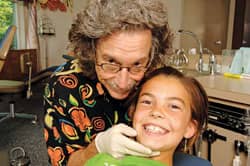
Vacuum-formed retainers have been a fixture of Samson’s practice for approximately a quarter of a century now. More recently, he has embraced self-ligating appliances and TADs, which, he believes, represent the future of orthodontics. “With self-ligating appliances, the central issue is not some magical gizmo or mystical incantation—it’s simply lower friction,” he says. The reduction of friction, he explains, allows sliding to happen more easily. “Theoretically—underline that word—the ease of sliding should reduce treatment time. Unfortunately, there have been no peer-reviewed journal articles to prove that, and as such I’m troubled by some companies’ marketing claims of incredible results with self-ligating appliances. That said, however, I firmly believe that a decade from now, most orthodontists will be using self-ligating appliances in one form or another. Due to the many mechanical advantages of an open-slot twin, self-ligating bracket system, my personal preference is SmartClip from 3M Unitek.”
Much the same will be true for TADs, he predicts. “They’re already causing a paradigm shift in orthodontics. From the standpoints of mechanics and treatment, TADs allow us to accomplish things that before were thought impossible. For example, there are patients being successfully treated with TADs who, in the past, could only have been helped by surgery.”
Biomechanics Made Zany
The most ambitious explorations into the possibilities of TADs are at present taking place in the orthodontic clinics of South Korea, Samson contends. Not eager to see American orthodontists fall behind, Samson plans to team up with leading US TAD advocate Jason Cope, DDS, PhD, later this year for a series of hands-on instructional presentations to better acquaint orthodontists here with the devices.
- Samson’s approach to orthodontics is “zany,” he says.
These presentations are expected to be chock-full of highly technical information, but the 30 or so participants in each session need not fret. Samson is famed the world over for his ability to impart complex concepts and data in an easily understood manner. “If you want to be honest about it,” he begins, “it’s fair to say my approach to explaining things is zany.”
Samson’s lectures are punctuated by antics, theatrics, occasionally edgy humor, audience participation, and a dollop or two of 1960s rock ‘n’ roll music to turn the glassy-eyed into energized learners. “Take biomechanics,” he says. “Most people find a lecture on that subject very difficult to absorb, let alone tolerate. Their response is to either fall asleep or fidget. But as difficult as biomechanics is to learn, it’s also perhaps the most important thing of all for an orthodontist to know. The way I overcome the barriers to learning this—or any subject, for that matter—is by teaching in the most entertaining and informative fashion possible.”
At a typical Samson presentation on biomechanics, each attendee is given an amply illustrated manual on the topic, plus sheets of tracing paper so that he or she can draw along as Samson sketches teeth, archwire positions, and force-moment arrows. “The hardest thing about teaching biomechanics is getting people to actually visualize how all these forces act and react,” he says. Accordingly, during the course of his lecture Samson shows computer-animated videos starring himself and comical 4-foot-tall painted plywood replicas of molars and incisors. “These teeth are almost like giant puppets that I move this way and that to illustrate Newton’s Third Law of Equilibrium, which is at the heart of biomechanics,” he says.
And if that isn’t enough to rivet the audience, the wild-haired Samson periodically unleashes 9-second-long snippets of Golden Oldies hits from his high school days. “The music comes up without warning and, when it does, I start bopping around the stage like a rock musician. I do this to give people’s brains a sort of seventh-inning stretch. It’s a very effective way to immediately refresh and refocus people’s attention before moving on to another part of the presentation.”
 |
 |
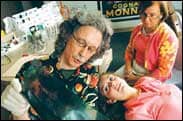 |
| The many faces of Gerry Samson. | ||
Samson derives his approach to teaching from an old professorial adage asserting that what a student hears he forgets, what he sees he remembers, and what he performs he understands. “Research into people’s learning styles indicates it takes an average of seven repeated readings of a highly technical text before that information even starts to sink in,” he says. “If that text is illustrated in some way, the information starts to sink in after only four or five repetitions. But if people get physically involved in the learning, then the information sinks in after being exposed to it as little as two or three times.”
Teaching Is a Trip
In addition to his practice, Samson runs a continuing education organization called (g)nathos inc—the Institute of Bioprogressive Education. (g)nathos is, he explains, “designed for participants who are looking to reach the next level.”
(g)nathos offers a very intensive learning experience that takes place over three 12-hour days in an Atlanta facility owned by Samson. Participants can chose among seven instructional modules. Enrollment is limited to 24 orthodontists at a time; usually, each class is filled to capacity. “We provide a very hands-on and practical style of teaching,” he says. “For example, a class will be divided into small work groups which will each be given a set of patient records from which they must as a team devise a treatment plan in accordance with the principles we discussed earlier in the session. We focus a lot on troubleshooting and what to do if things aren’t progressing as planned at each visit.”
Samson’s work with (g)nathos is in addition to his teaching duties as an associate professor at St Louis University, Case Western University and the University of Nevada, Las Vegas, and as an adjunct professor at the University of Texas, San Antonio. He also is a guest lecturer at seven other universities in the United States, Australia, New Zealand, and China.
Add it all up and it’s plain that Samson eats, sleeps, and breathes orthodontics. So, how does he relax? By talking orthodontics and facial balance to anyone who can keep up with him. An inveterate globe-trotter, Samson says he loves visiting and studying other countries and other cultures, especially those of the Far East. His wife—retired general dentist Betty Ann Samson, DDS, whom he met at a social gathering in Atlanta during his senior year at Emory—seldom accompanies him on international trips, contenting herself to instead relax at home or in their mountain cabin with their pair of Briard sheepdogs.
Ask Samson what he likes best about orthodontics and he will tell you it is the fact that it is elective care, “not anything grim,” he says. Ask him that same question 5 years from now and no doubt he will give you the same answer, but his response will be delivered from a slightly different frame of reference—of that he is sure. “I intend to be farther down the road in 2012. By that, I mean more into lecturing, less involved in clinical practice, and just enjoying life as fully as I possibly know how to.”
Rich Smith is a contributing writer for Orthodontic Products. For additional information, please contact
The Long and Winding Road
There is an overarching theme to the lectures on biomechanics given by Atlanta-area orthodontist Gerald (Gerry) Samson, DDS, ABO, FACD. It is that if an ordinary mind like his can grasp so challenging and complex a subject, anyone’s can.
“Learning has never come easily for me,” he confesses. “I’ve always had to make extra effort to ‘get’ new concepts and information.”
Among the very first to realize this about Samson was his father, a first-generation American of Russian stock who settled in Milwaukee with Gerry and Gerry’s older brother—both of whom were in dire need of orthodontic work. “I had one of the worst Class II, Division 1 conditions in recorded history,” Gerry Samson recalls. “It was so bad that I could eat a sandwich through a picket fence.”
Not having completed high school, pÈre Samson was by no means a man of means. That made providing orthodontics for his sons financially daunting. Fortunately, he found a local orthodontist who proposed a mutually acceptable arrangement by which the younger Samsons could each receive treatment.
It was Gerry Samson’s experiences with this doctor—the late George Hulen, DDS, MS—that convinced him to aim for a career in orthodontics. “Just the warm and welcoming way Dr Hulen and his staff received me made a huge impression,” he tells. “I remember walking into that office for my first appointment, and everyone saying hello to me—by name. That simple act of etiquette was really important to an 11-year-old kid with a big self-esteem problem.”
Samson also was impressed by the raucousness of Hulen’s office. “His hobby was jazz trumpet, so there was jazz music playing all the time. And he was constantly running around the place, just having a ball. Everything Dr Hulen did was fun. He could be off-schedule by 2 hours and nobody cared. That’s how much the staff and the patients enjoyed being there.”
Having decided to follow in Hulen’s footsteps, in 1966 Samson enrolled at the University of Wisconsin, Milwaukee, as a predental student. After his freshman year, he transferred to Marquette University, graduating in 1970 and entering its dental school a year later. Samson enjoyed a slight advantage over some of his classmates in that he had been working since his senior year of high school as Hulen’s lab helper.
He then went on to a residency in pediatric dentistry at Emory University in Atlanta. With that under his belt, Samson put his career training on hold for a time to tour Europe and reflect on the life choices that lay before him. On the island of Crete, it at last hit him that orthodontics was indeed his true calling. Samson returned to the United States and, in 1979, applied to enter the highly competitive orthodontic program at Northwestern University in Chicago. A Northwestern orthodontic resident—former Emory classmate Carl Muster, DDS—persuaded the program’s chairman—Harold Perry, DDS, MS, PhD—to let Samson in. Samson completed training in 1981, then began private practice in Atlanta.
—RS


